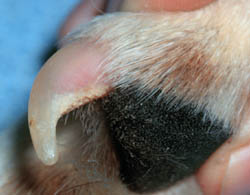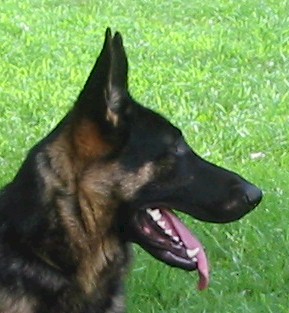|
Sequoyah German Shepherds


















 Take a look at the page below to see some orphans that need a loving home!
 |
Last
updated 7/1/07
Nail Trimming
-- the "Quick" and Easy Way.
Trimming nails on dogs is often a hard-fought war, with
bloody casualties on both sides. Because of that, many people leave the
task to their veterinarian. Believe me, I know! But unless you're seeing these
professionals a lot more than most people do, it may be that your pet's nails aren't
being trimmed enough.
If you are anticipating learning to trim your own pet's
nails, I recommend that you visit your local veterinarian or groomer for
a demo, then prepare to do battle yourself. Keep in mind, though,
that not all dogs need their nails trimmed.
Many
will naturally wear the nails down or the dried ends of the nails will
simply flake away without you even knowing.
Getting Started....
Few dogs enjoy nail cutting but most, with training,
will learn to allow their nails to be cut without a major struggle.
If your dog is resistant to nail trimming, work up to the
task over a few weeks' time by taking the trimmer in hand and touching
it to his/her feet, then the toes, then the nails, while praising him/her and
giving treats for each step. When he/she is used to having their feet
handled, put the trimmer against the nail and praise and treat more
still. Finally, trim a little off, and so on. Praise and more praise! Treats
and more treats! Don't insist on getting all the nails done at once. Do
one or two toes a night, and put the nippers away while both you and the
dog are feeling positive about the experience. When you know that
the nail trimming process is not a scary one, then you can progress to
insisting that your dog be a little more tolerate of it.
Many dogs object to nail cutting because someone has clipped their
nails too short in the past and hurt them. Similar to our nails,
dog toenails have a nerve and a blood vein inside them. When cut too
short, it causes pain and bleeding.
The live area in toenails that are white or very light
colored is easy to determine. The section with the nerve and vein is
pink while the dead part is white. Most dogs, though, have black
toenails making it impossible to see where one area ends and the other
begins. By holding the foot with the pads facing up, it's often easy to
see this distinction no matter what color your dog's nails are.
Along the bottomside of the nail, you'll see a groove. It begins
at the tip of the toenail, where its outline is very sharp, deep and
distinct. The groove continues toward the toe, becoming wider and
shallower until its outline blends in with the rest of the nail and
seems to disappear. The part of the toenail with a deep, distinct groove
is the dead area. There is no nerve or blood vein in that section and
you may safely cut it off without harming the dog.
If the groove is not obvious, you can
check the end of the nail. The dead area usually is whitish and as you
cut deeper into the end of the nail you will begin to see a dark area.
This dark area is where the live part starts. Cut dark
colored nails in several small cuts to reduce the chance of cutting into
the quick.
But you
might as well count on cutting a nail too short on occasion. I'll bet I
have trimmed tens of thousands of canine and feline toe nails and once
in a while I do get too close and the bleeding starts! That's when
having some clotting powder or solution will save the day! If no
Kwik Stop is available, corn starch, flour, or baking powder will also
do the trick. Press the powder to the bleeding area and hold until
the bleeding stops.
Here is a picture of a white nail that allows you to
better visualize the actual make-up of canine nails.
 
Keep points to
remember:
*Keep sharp nail trimmer -- the
sharper they are, the less they pinch the nail during the cut.
*Reward with treats and praise for
good behavior.
*If the nail is cut to close, a
pinch of flour, baking powder, or corn starch will help stop any
bleeding if Kwik Stop is not available.
*I usually start trimming the rear
feet first - dogs seem to be better about these, perhaps because
they can't see what you're doing.
What if the quicks have grown out too
far?
If your dog's nails are so long that they're forcing her foot out of
position, you can take them back to where they should be in two ways.
- The first is to cut a little off every few days: The quick recedes
before you as you go.
- The second way is to have your veterinarian take
them all the way back at once when your dog is under anesthesia, such as
for a teeth-cleaning. After the nails are at a proper length, keeping
them that way is easy with a weekly trim.
Grinding nails as an Option to Nail Trimming:
Some dogs
prefer having their nails ground instead of clipped, perhaps because
with a grinder it's easy to stop before you hit the quick. You can buy a canine
nail grinder, or just use a lightweight rotary grinding tool, such as
the Dremmel.
Some dogs find it more tolerable to have their nails ground rather than
clipped. As with clipping nails, going slowly and using lots of praise
and treats along the way is key to a good experience for both you and
your pet.
Important
things to remember when grinding --
- Nails can
get hot while you're working on them. Don't grind continuously.
Touch the grinder to the nail in very short bursts -- a second
or two at most -- to keep the heat from building up.
- Don't push
the grinder against the nail -- just hold it there and let the
grinder do the work.
- Grind across the bottom and then carefully in from the tip of the
nail. If you do this weekly, the quick will recede, and you'll be able
to maintain short nails on your dog with ease.
This is actually a much more
comfortable method of maintaining nails than clipping them because it
does not pinch or hurt the quick.
|

